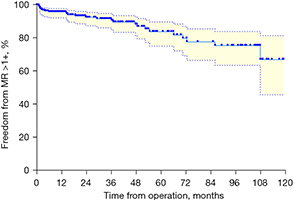Robotic mitral valve repair—the Bruxelles experience
Abstract
Background: Although the use of the surgical robot facilitates less invasive mitral valve surgery, both real and perceived limitations have slowed the application of this technology. Aim of the present investigation was to report the early and long-term results of robotic mitral valve repair in a single institution over a 10 years period.
Methods: Between March 2012 and May 2022, a total of 278 consecutive patients underwent robotically assisted mitral valve repair at the Cliniques Universitaires Saint-Luc (Brussels, Belgium). Indications have evolved over time allowing to treat complex mitral valve lesions. Clinical and echocardiographic follow-up were 97.8% and 86.1% complete, respectively.
Results: Mean age of the study population was 57.8±11.9 years and 221/278 (79.5%) patients were male. Despite being asymptomatic or mildly symptomatic [New York Heart Association (NYHA) class I–II], most of the patients presented with severe mitral regurgitation (MR). Degenerative mitral valve disease was the most common cause of MR. All patients underwent successful mitral valve repair using different techniques, and 25/278 (9.0%) had one or more concomitant procedures associated. The mean cardio-pulmonary bypass and aortic cross clamp times were 153±37 and 106±25 minutes, respectively. There was no operative or in-hospital mortality. Overall survival rate was 97.8%±3.2%, 95.8%±3.2% and 93.7%±3.0% at 3, 7 and 10 years. One early (0.4%) reoperation with re-repair was recorded for ring disruption, while late mitral valve re-repair was necessary in 4/279 (1.4%) patients for recurrent severe MR in three of them and mitral endocarditis in one. The overall freedom from mitral valve reoperation was 98.1%±1.0% at 3, 7 and 10 years. Overall freedom from MR (grade 2+ or more) was 91.7%±3.2%, 77.8%±4.8% and 67.1%±9.2% at 3, 7 and 10 years, respectively.
Conclusions: Robotic mitral valve repair is safe and is associated with excellent clinical and echocardiographic results. The use of robotic technologies allows, after an appropriate learning curve, to reproduce all conventional techniques to treat MR, regardless the complexity of the valve lesion.
Cover






